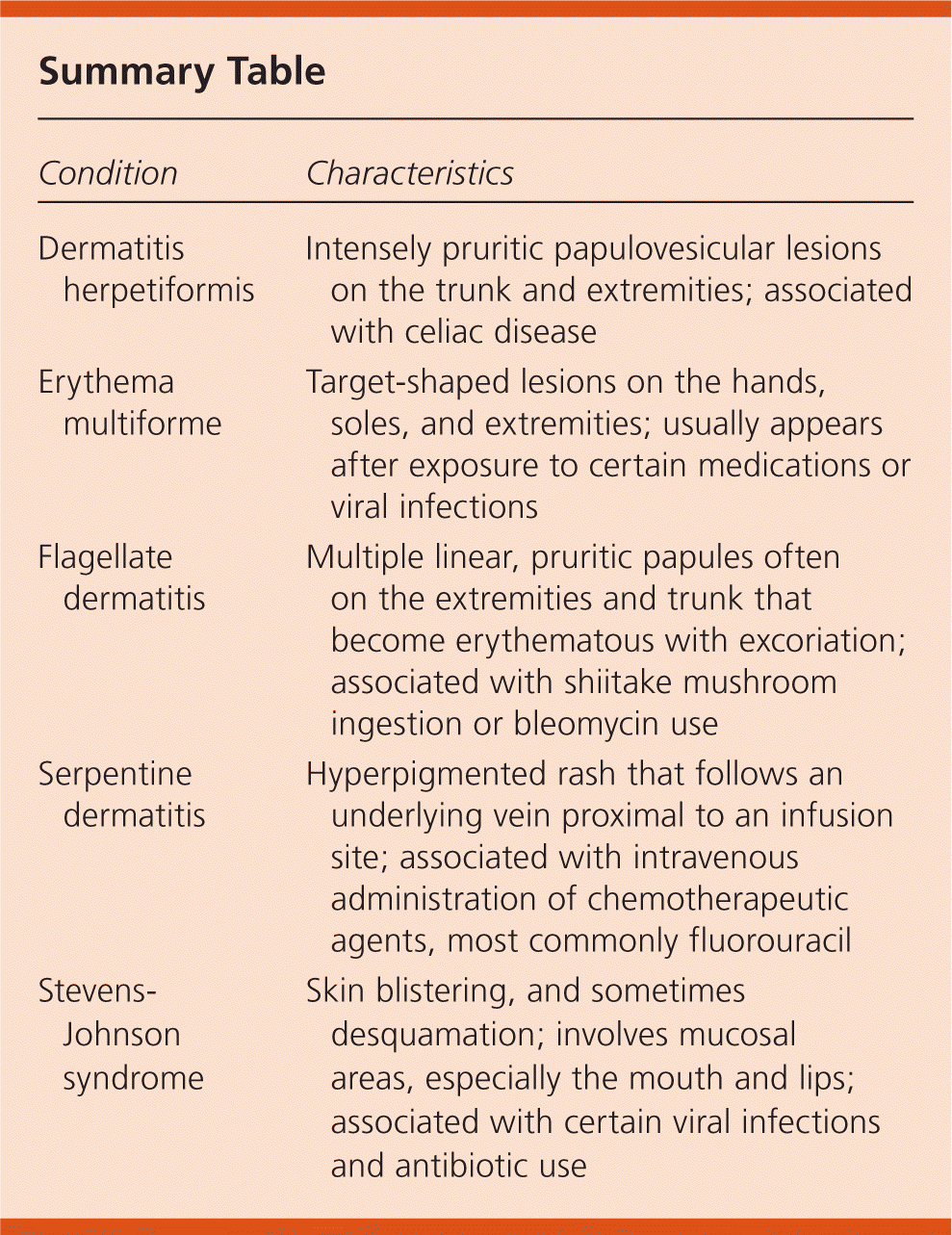
Am Fam Physician. 2013;88(9):605-606
Author disclosure: No relevant financial affiliations.
A 34-year-old man presented with a pruritic, erythematous, papular rash that appeared two days earlier. The rash started on his trunk and back, then progressed to his arms and the proximal portion of his legs. He did not have pain, burning, or a tingling sensation. He did not have a fever or other systemic symptoms, and the review of systems was otherwise unremarkable. He did not have sick contacts and was not using any new medications, soaps, lotions, or detergents. He ate a salad with shiitake mushrooms, pine nuts, and organic corn the day his symptoms started.
Physical examination revealed diffuse, linear papules over the extremities and trunk (see accompanying figure). There was no tenderness, induration, warmth, scaling, or exudate.

Question
Discussion
The answer is C: flagellate dermatitis. Flagellate dermatitis is a diffuse rash that most commonly occurs after exposure to the chemotherapeutic agent bleomycin, but it can also occur with shiitake mushroom ingestion.1,2 It presents as multiple linear, pruritic papules that become erythematous with excoriation. The rash is often located on the extremities and trunk. Similar cutaneous manifestations occur in patients with dermatomyositis, Still's disease, and human immunodeficiency virus infection.2
The diagnosis of flagellate dermatitis is clinical and based on the history and appearance of the rash. The dermatitis usually begins within the 24 to 48 hours after ingestion of raw or partially cooked shiitake mushrooms, and has an average duration of eight days.2 In contrast, symptoms associated with bleomycin use occur up to nine weeks after initial exposure and can last up to six months after discontinuation.1,2 The rash is treated by eliminating exposure to the causative agent, and with topical and oral steroids and antihistamines. Patch testing is not recommended, and skin biopsies are nonspecific.2
Dermatitis herpetiformis is an intensely pruritic papulovesicular rash on the trunk and extremities. It is an autoimmune disease with a clear association to celiac disease and gluten sensitivity. Only 15% of patients with the rash have digestive manifestations of celiac disease.3 Both entities have similar pathophysiology and subsequent gluten-sensitive enteropathy. The rash dissipates with withdrawal of gluten from the diet.
Erythema multiforme usually manifests as target-shaped lesions on the hands, soles, and extremities. It is the result of a type IV hypersensitivity reaction to an infection, connective tissue process, or medication use (classically nonsteroidal anti-inflammatory drugs, antiepileptics, sulfonamides, or antibiotics), or it can be idiopathic.4
Serpentine dermatitis is associated with intravenous administration of chemotherapeutic agents, most commonly with fluorouracil. The rash has a similar morphology to flagellate dermatitis, but with a hyperpigmented pattern that follows an underlying vein proximal to an intravenous infusion site.5
Stevens-Johnson syndrome is a more serious and possibly life-threatening form of erythema multiforme. It can lead to skin blistering and possibly desquamation, and involves mucosal areas, especially the mouth and lips. Fever, malaise, and upper respiratory tract symptoms are common in the days preceding Stevens-Johnson syndrome. The condition is commonly associated with use of certain medications, especially antibiotics and sulfa drugs, but can also be triggered by viral infections, such as herpes simplex virus, influenza, and Epstein-Barr virus.4

| Condition | Characteristics |
|---|---|
| Dermatitis herpetiformis | Intensely pruritic papulovesicular lesions on the trunk and extremities; associated with celiac disease |
| Erythema multiforme | Target-shaped lesions on the hands, soles, and extremities; usually appears after exposure to certain medications or viral infections |
| Flagellate dermatitis | Multiple linear, pruritic papules often on the extremities and trunk that become erythematous with excoriation; associated with shiitake mushroom ingestion or bleomycin use |
| Serpentine dermatitis | Hyperpigmented rash that follows an underlying vein proximal to an infusion site; associated with intravenous administration of chemotherapeutic agents, most commonly fluorouracil |
| Stevens-Johnson syndrome | Skin blistering, and sometimes desquamation; involves mucosal areas, especially the mouth and lips; associated with certain viral infections and antibiotic use |
